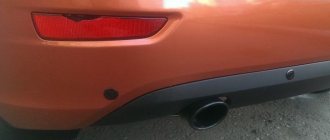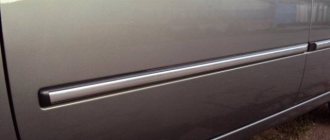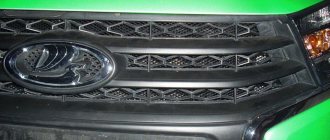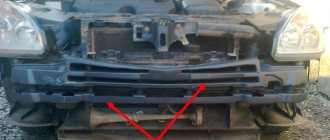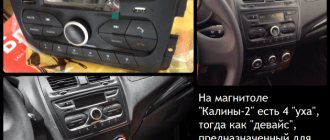Comments: no Published: 06/13/2016
Rating:
Tags:VAZ Kalina
Owners of Lada Kalina 2, who want their car to stand out among hundreds of others, usually resort to tuning, which involves repainting the body, installing spoilers or bumpers.
Often a way to make a car stand out is to install a mesh guard under the grille, which also defines the car's exterior. In addition to improving aesthetics and the function of redistributing the flow of air masses, installing additional protection protects the radiator from contamination and damage.
The latter may occur for reasons such as:
- flying insects;
- ingress of plant fluff;
- impacts of stones flying from under the wheels.
Protective mesh for the LADA Kalina 2 radiator.
A special feature of the Lada Kalina 2 is that in it the radiator, which is responsible for cooling the engine, is located almost at the same level with the front bumper. A radiator with large cells should protect the fins of the heat exchanger. Because of this, despite the fact that the grille protection is made of aluminum or steel, many Lada owners install additional protection on it in the form of a fine-pitch mesh. Such products have different shapes.
Even if a small stone passes through a large grille, its further path will end near the tuning in front of the Lada Kalina 2 radiator, so it will not damage the thin radiator tubes.
Despite the laboriousness of the operation, based on all the available methods for tuning the Lada Kalina 2, this method is one of the most inexpensive. With the proper culture of using certain tools, it can be done with your own hands. The end result makes the Lada's exterior more aggressive and powerful.
Chrome mesh for the radiator grill of Kalina 2
Basic radiator malfunctions
Malfunctions of this Kalina unit do not occur so often and are the result of wear and tear due to natural causes of the car owner’s negligence. There are two most common types of problems:
- coolant leak;
- coking of cavities inside the radiator.
Leaks are dangerous because a decrease in coolant level leads to an increase in engine temperature. This leads to overheating and jamming of the motor. A leak of hot antifreeze can be dangerous. The fluid in the system is under pressure, a leak can form a fountain, and contact of hot antifreeze on exposed skin will cause burns.
Coking disrupts the antifreeze circulation process. As a result, the lower part of the radiator begins to cool, and then the entire heat exchanger. The liquid will not cool, causing the engine to overheat. In most cases, the cause of coking is ordinary scale. This happens when tap water is poured into the SOD. Less commonly, blockages occur due to mixing oil and antifreeze. In this case, the reason is the loss of tightness of the cylinder head gasket.
At an early stage, coking is difficult to detect. In advanced cases, mixing oil and antifreeze forms a consistency similar to jelly, which makes the heat exchanger tubes difficult to pass or completely impassable.
Installation of the mesh, method of its fastening
The lower radiator grille is pressed to a part called the “bumper” using self-tapping screws. They will need to be unscrewed, but the grid should remain in place - then a mesh blank is placed on it. Using ties, we press the protective mesh to the plastic structure. Lastly, you need to tighten the screws that should hold the grille and mesh together.
The result of tuning Kalina-2 - a protective mesh was installed
VAZ continues to improve the design of mass-produced cars all the time. However, it is unlikely that they will change the shape of the radiator grille - this will require making new stamps, etc. Well, it would be difficult to carry out the modifications that we discussed here in mass production conditions. Conclusion: anyone who needs it can install the protective net themselves. There are no other options available.
In fact, large mesh grilles are used on many modern cars. These include: Kia Rio hatchback, Renault Duster crossover, Volkswagen Turan minivan, etc.
Replacing a radiator on a viburnum
There are two brands of heat exchangers on the automotive aftermarket:
- DAAZ is a standard radiator, the cost starts from 1,700 rubles.
- LUZAR is the second most popular after the factory one. Costs about 1800 rubles.
Foreign manufacturers can also offer good options at low prices: for example, Hofer.
Replacing the cooling radiator on Kalina begins with preparing the tool:
- set of socket heads;
- ratchet driver;
- extension;
- screwdrivers with shaped and flat blades;
- pliers.
Before you begin dismantling the radiator with your own hands, you need to drain all the antifreeze from the system into a suitable container. Before any manipulations, the on-board network must be de-energized; to do this, disconnect the “negative” terminal from the battery. The withdrawal process is as follows:
- The car is placed on a level surface.
- The engine protection is removed from below. This makes it easier to drain the coolant, otherwise it will spill over the metal sheet.
- After the engine has cooled down, you can begin draining the antifreeze.
- The air filter box is removed.
- The ignition coil is removed to facilitate access to the drain plug on the cylinder block. It is recommended to disconnect high-voltage wires.
- Use a 13 mm wrench to unscrew the drain plug on the block. Place a container under the drainage area.
- The lower radiator hose is removed. The cap of the expansion tank must be unscrewed - the system will depressurize and the coolant will drain out faster.
- After all the liquid has poured out, the drain plug is screwed back on.
- Use a screwdriver to remove the clamp with the throttle valve heating pipe.
- The connector is disconnected from the fan.
- Unscrew the 4 frame bolts that hold the fan to the radiator. To remove the knot, you need to pull it up.
- All pipes should be removed from the radiator fittings by loosening the clamps.
- Unscrew the remaining 2 nuts with a 10 mm wrench, with the help of which the heat exchanger is attached to the body.
- Tilt the radiator towards the engine and pull it up to remove it.
New Lada: Window deflectors Lada Kalina station wagon in Balashikha
